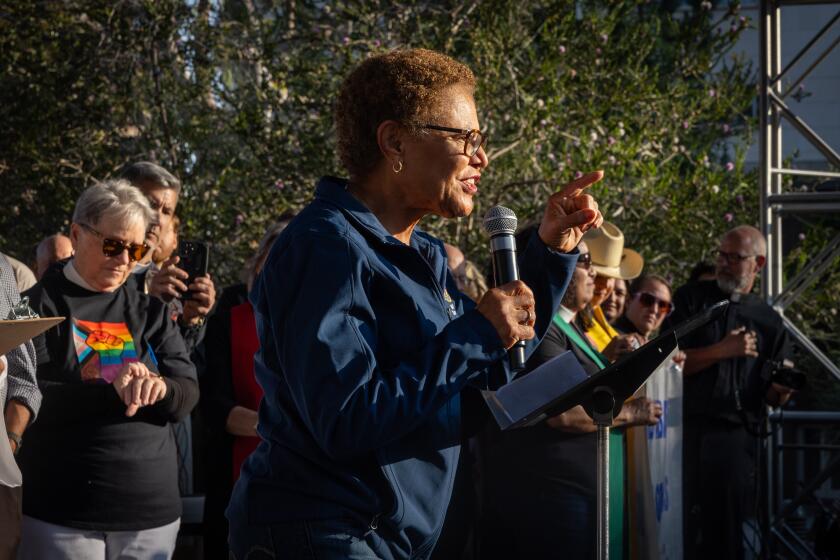This video game can help seniors get into college
- Share via
High school senior Alex Chinchilla sometimes missed deadlines for college recommendation letters and essays. The consequences were great — but not real.
He was playing a video game meant to encourage students like him to apply to college and follow through on deadlines and application requirements. His delays in the game killed his avatar’s chances to attend college, but the virtual failures focused Chinchilla on his own actual applications.
It helped the Foshay Learning Center student “get my act together and make sure I’m turning everything in on time,” he said.
That reaction is exactly what the USC education and technology professors who created “Mission Admission” hope for. The game is aimed at encouraging college enrollment for low-income students whose parents probably did not pursue higher education and whose counselors may not be able to provide enough attention.
With competitive but lighthearted tasks and rewards on the road to campuses with names such as Outdoors University, the game seeks to familiarize players with exams, application essays, financial aid forms and deadlines.
“It is taking something that is very complex and scary and making it more accessible,” said Zoe Blumberg Corwin, research director at USC’s Pullias Center for Higher Education. The center and USC cinema school’s Game Innovation Lab have developed college application-related games for about five years, starting with a card game, and more recently tested their “Mission Admission” on a modest scale.
The playing field is expanding. The U.S. Department of Education recently awarded the USC project a $3.2-million grant to encourage innovation in higher education. The award will help transfer the game from Facebook to apps and Internet platforms and test it on 5,000 students in 50 California high schools.
Preliminary research found that students who played the game at least twice showed increased knowledge about the application and aid process. Its USC creators now want to see if it influences students to apply to college and enroll in greater numbers than others who don’t play it.
The game is part of a wider effort to use more technology in seniors’ college searches beyond the popular online Common Application. More recent websites and phone applications match students to schools and inform them about financing.
Among them: The online College Abacus projects costs and likely aid; PossibilityU offers advice videos; the Naviance Student app helps organize tasks; the College Board’s Big Future searches for schools. Others lead virtual campus tours.
The game and the apps attempt to appeal to “our increasingly technology-focused culture,” said David Hawkins, public policy and research director at the National Assn. for College Admission Counseling. But their usefulness remains uncertain, he added.
David Soo, a senior policy advisor in the federal education department, said the USC game holds the promise of “getting more students in the mind-set of applying to college.” But he said it faces a high bar of proof and much evaluation.
“Mission Admission” players select a character with educational goals and a family income and try to get that character to college with enough financial aid. Avatars must keep planning calendars and visit the cartoon-like counseling and writing centers for such tasks as requesting recommendations and performing community service, earning points to progress.
At Foshay Learning Center, a large L.A. Unified campus about a mile west of USC, students like Chinchilla were among early testers. Computer science teacher Leslie Aaronson, who coordinates the school’s technology academy, said the game provides a lot of information in a friendly format. Students “are learning through interactive play versus adults wagging their fingers at them,” she said.
Students complained that the “energy” that allows players to proceed is too slow and that graphics seem backward. But in general, they said they appreciated the game’s goal.
“It helps you into the mentality that you have to plan things beforehand and you shouldn’t just do the minimum requirements. You should go beyond,” said Hector Ramirez, 16, a junior who wants to study computer science.
Before the federal grant, the game’s development cost about $4 million, including backing from USC, the Gates Foundation and the Gilbert Foundation, said USC higher education professor William G. Tierney, co-director of the Pullias Center.
A new company called FutureBound Games, in which USC owns a share, was formed to help plot the game’s future, move it off Facebook and try to keep it free for students after the testing, he said.
No matter what the experiments prove, Tierney said that players “will learn that deadlines matter.”
Twitter: @larrygordonlat
More to Read
Sign up for Essential California
The most important California stories and recommendations in your inbox every morning.
You may occasionally receive promotional content from the Los Angeles Times.














